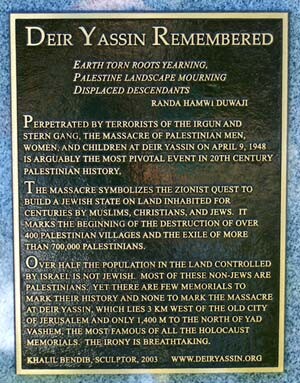The Electronic Intifada 26 September 2003

The plaque on the sculpture. (DYR)
On April 9, 1948, members of the Irgun and the Stern Gang massacred over 100 Palestinian men, women and children in the village of Deir Yassin, near Jerusalem. The Deir Yassin massacre marked the beginning of the depopulation of over 400 towns and villages, and the exodus of 750,000 Arabs; it also marked the beginning of the Palestinian Nakba, or catastrophe, and the creation of a Palestinian diaspora in refugee camps and in neighboring Arab countries.
But why build a memorial to the victims of Deir Yassin in the US? For Palestinians and most Arabs to remember Deir Yassin is a form of resistance to the humiliation and dehumanization Palestinians have suffered for over 55 years, much of it sponsored and nurtured by the United States, through its unwavering support for Israel. To memorialize Deir Yassin is a cry for the world to remember the ethnic cleansing Palestinians have endured, and the apartheid conditions under which they now live.
Quite simply, for Palestinians remembering Deir Yassin says: “You stole our history; we want it back. We shall not allow our history and the narrative of our dispossession to be ignored.” If Kelcie, in Poland, is hallowed ground where Jews were massacred, Deir Yassin is hallowed ground where Palestinians were massacred. And that ground is within sight of Yad Vashem, the famous Holocaust museum, where the world is taught to “never forget” and that “hope lives when people remember.”
Today, half the people between the Mediterranean and the Jordan River are not Jews; most of the non-Jews are Palestinian. Their history is also important. Contrary to popular mythology, there never was a “land without people” before the Jews arrived. Nor were Palestinians persuaded to voluntarily leave their land by their leaders. They were driven out in 1948 and in 1967, deliberately and with malice. There was no “purity of arms” at Deir Yassin. Those who committed the crimes were hardly a “light unto nations.”
As writer Elie Wiesel often proclaims: “The opposite of love is not hate; it is indifference.” If so, the indifference shown toward Palestinian history, in Israel and in the US, is worse than hateful. Jews rightly protest against Holocaust denial, and the world listens. Palestinians rightly protest against Nakba denial and are often told: “Get over it.” In either case, such denial is hurtful and is no basis for peace.
The Geneva memorial is a bronze sculpture depicting a mature olive tree, a symbol of peace, uprooted in the quest to build a Jewish state on land owned and long-inhabited by Muslim and Christian Palestinians. The treeís tortured, angular lines illustrate the Palestinian dispossession that began in 1948 and continues today. The extended branches add movement and drama; they appear dead and yet are still alive. The torn roots of the displaced olive tree are partially wrenched from the earth; their continued attachment to the ground symbolizes clinging to the motherland.
Members of Deir Yassin Remembered believe there cannot be true peace as long as the truth is avoided and as long as the sad history of the Palestinians is ignored.

The sculpture in the morning light. (DYR)

The back of the sculpture. (DYR)
Daniel McGowan is executive director of Deir Yassin Remembered. This commentary originally appeared in The Daily Star (Lebanon).


